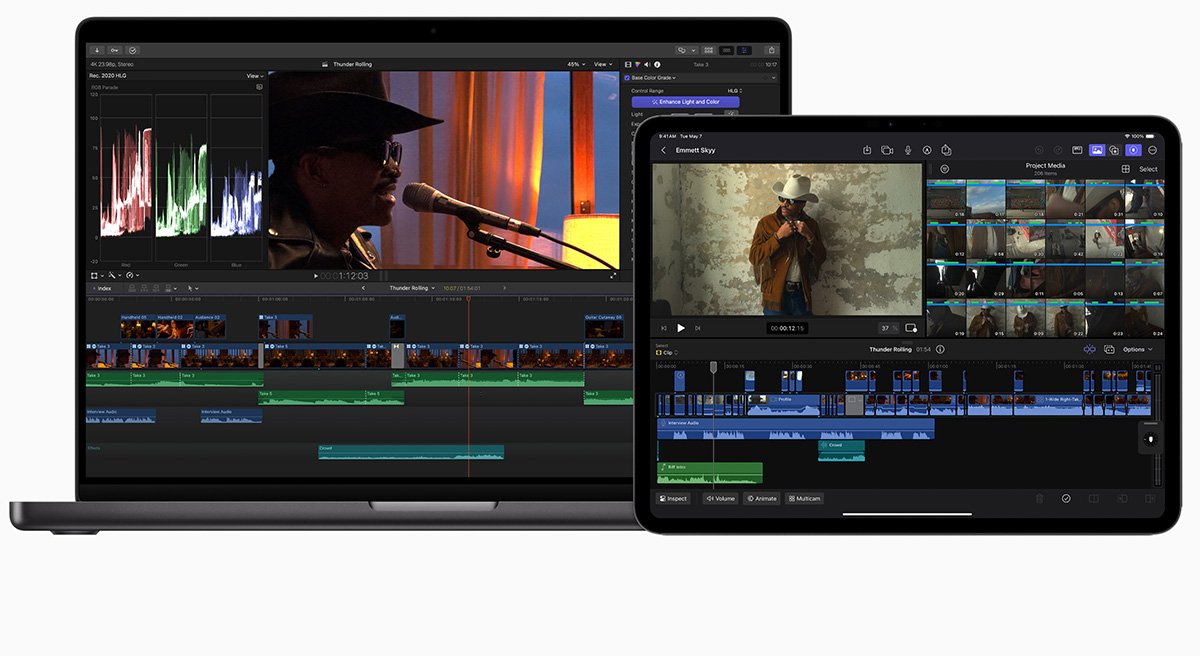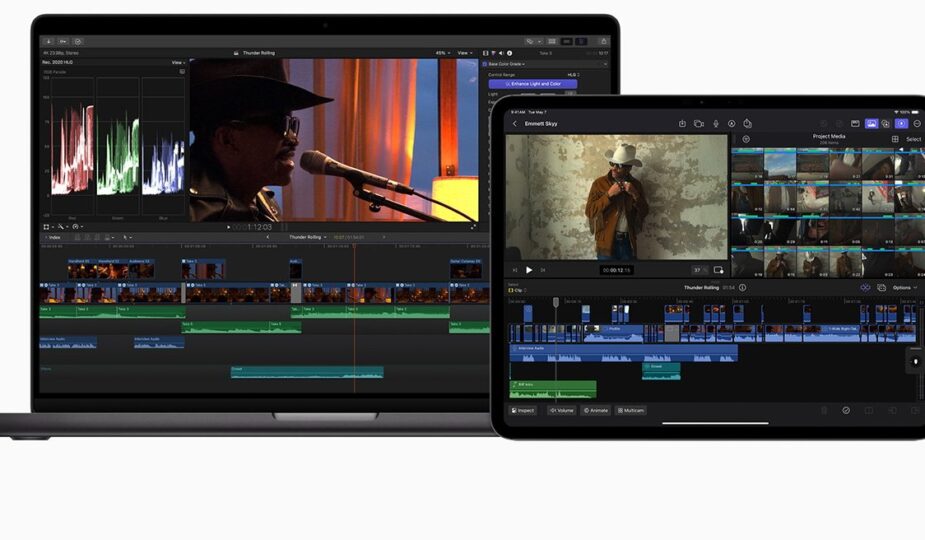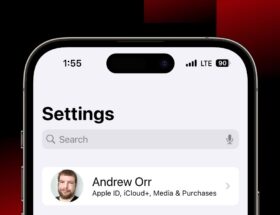Apple's New Final Cut Pro for iPad 2 and Final Cut Pro 10.8 .
 7 Facebook x.com Reddit
7 Facebook x.com Reddit
Along with the launch of the new iPad Air and iPad Pro lines, Apple showed off Final Cut Pro updates for iPad and macOS — but they have a different set of functions. Here are the key differences and things to look out for.
Final Cut Pro for iPad 2 is a major shift in the iPad editing experience, but Final Cut Pro 10.8 is a modest update. The result is two different tools with different tools having the same name.
While competitors have added a host of artificial intelligence tools and workflow improvements to their desktop versions, such as transcript-based editing, advanced object tracking and masking, and more, Apple appears to be focusing most of its efforts on the iPad. version.
To determine which application — or if both applications — right for you, it's important to learn the history of the apps, their differences and, more importantly, their unique strengths.
Apple's clumsy naming decision is a problem for users
I've been using Final Cut Pro for years — first exclusively, and now as one of the tools in my editing arsenal — and, like many users, were hoping for major updates. I also use the iPad version and appreciate the updates, but they are increasingly becoming two different tools.
Final Cut Pro for iPad is both identical and different from the Mac version.
Final Cut Pro for iPad 2 adds new features that take the mobile app in a completely different direction than the Mac version. The iPad version now supports capturing data from mobile devices, something that would be difficult to achieve on a Mac.
In other words, Final Cut Pro for iPad and Final Cut Pro for Desktop are two different video editing systems that share the same name but have different audiences and features.
Adobe avoided this problem by calling the mobile-only version of Premiere “Premiere Rush.” It might make sense if Apple excluded Pro from the iPad version instead of adding iPad to the end of the name.
BlackMagic's DaVinci Resolve video editing suite takes a different approach than Adobe or Apple, making the iPad version as close to the desktop version as possible.
The iPad version of Resolve lacks some desktop features, but is incredibly similar, basically a scaled-down version that accommodates different UI options.
BlackMagic's DaVininci Resolve for iPad is an exact replica of the desktop version
Computing power likely contributes to features not found in the iPad version of Resolve, so It will be interesting to see how the new iPad Pro M4 impacts development.
History and development of Final Cut Pro and Final Cut Pro for iPad
Final Cut Pro (FCP) has been part of Apple's flagship professional creative tools product for more than two decades, but it didn't arrive on the iPad until May 2023. Almost a year later, Apple just released Final Cut Pro for the iPad 2.
During the same product launch as Final Cut Pro. for iPad 2, Apple also announced that Final Cut Pro for Mac will be updated from version 10.7 to 10.8. As stated in the point release, this update does not include changes to core features, but does add some AI-driven features.
Final Cut Pro for iPad did not provide feature parity with the Mac version at launch. The discrepancy between them was not particularly surprising. FCP is an extremely complex program that has been in development for decades and uses significant computing power to create feature-length projects.
Apple capitalizes on these differences and uses the iPad version to showcase the capabilities of devices like the M4 iPad Pro. However, the different naming conventions and lack of clear comparison guidelines can be confusing.
At the risk of sounding overly simplistic, it's worth considering Final Cut Pro for iPad as a mobile-first editor solution. Final Cut Pro for Mac is a tool for more advanced video editing. The type of content you create should indicate which version to use.
Hardware differences determine different capabilities
Before Rather than discussing software differences, it's important to note that the release of Final Cut Pro for iPad 2 demonstrates the power of iPad Pro and the benefits of an all-in-one mobile device.
Apple Final Cut Pro for iPad 2 takes advantage of the new capabilities of the iPad Pro.
The new iPad Pro features an advanced screen that Apple calls Tandem OLED. By combining two OLED panels, the new iPad Pro has an outstanding color palette.
The color reproduction of the new iPad Pro is amazing for video editors. The display accurately reproduces standard dynamic range (SDR) and high dynamic range (HDR) content.
As the name suggests, SDR content is designed to be played back on traditional monitors and TVs, while the wider range of colors in HDR content requires more advanced displays such as the iPad Pro, iPhone Pro and many 4K TVs.
The problem with HDR displays is that they are needed to adjust colors and evaluate reproduction. Standalone HDR displays can be expensive, but iPad Pro meets both needs. The new iPad Pro can evaluate HDR content because the iPad can be used as a secondary display for the Mac.
Final Cut Pro for iPad and Final Cut Pro for Mac
It is better to discuss the main differences between the two platforms to understand the growing differences between Final Cut Pro for iPad 2 and Final Cut Pro for Mac.
It's easiest to start by discussing what Final Cut Pro for iPad lacks compared to the Mac version, since the omissions are more noticeable than the similarities.
Organization
FCP for Mac organizes libraries that can host events and projects. A large library is the main organizational tool. The library system allows editors to create different repositories for things like clients, jobs, or users.
Final Cut Pro for Mac has a different set of tools than FCP for iPad
Libraries, in turn, can contain events and are most often used for organizing specific filming. An event can contain clips or projects. A project is one editing session, essentially one timeline.
The library, events and projects system makes it easy to move work around. Any other FCP Mac user can open the library, which can contain all the source material for simplicity and efficiency.
I can still access any Final Cut Pro library I was using and start working without having to search for discs or footage because I archived them all as libraries containing media.
In FCP for iPad there are only projects, and since the desktop organization is based on libraries, it is not possible to open a library in the iPad version. This eliminates the possibility of cross-platform and cross-user collaboration when using the iPad version.
Importing and working with content
FCP for iPad has a similar number of sources used for importing, but with some unique limitations. You can import media from internal storage, an external connected drive, iCloud Drive, and a media card connected using an external reader. However, you cannot import a number of files; it's all or nothing.
The ability to import from the internal camera is unique to the iPad version (and radically improved in the latest update). Final Cut Pro's mobile image capture feature for iPad is its defining feature and the direction in which Apple will continue to move.
Starting with M2 models, the iPad version of Final Cut Pro can capture in Apple's high-quality ProRes format, which the iPhone is also capable of. [https://appleinsider.com/inside/iphone-15-pro/tips/how-to-get-the-best-video-capture-possible-on-iphone-15-pro-with-prores]
Color Management
Final Cut Pro for iPad 2 adds some color adjustment tools, but still lags behind Final Cut Pro. Setting color in the iPad version is the same as setting color in the Photos app.
You can manually adjust the color using sliders, use a set of color correction settings (such as enhancing highlights or applying tint to shadows), or adding a “color effect,” which is essentially a filter.
The Mac version contains more professional color selection and adjustment tools suitable for TV and film production. Users can also use plugins and filters to fine-tune colors.
Audio Editing
Final Cut Pro for Mac has powerful audio tools, and editors can work with dialogues and effects. However, Final Cut Pro for iPad has more limited audio capabilities, but does boast some great features.
Any clip can be assigned dialogue, effects or music, and in the desktop version you can create subtitles or edit role titles.
The iPad version supports muting, adjusting multiple clips at once, panning, fading, noise removal, and isolation effects to clean up tracks. There is no way to run sound effect plugins on Mac.
Final Cut Pro for iPad 2 and Final Cut Pro for Mac diverge
The first version of Final Cut Pro for iPad supports multiple cameras was limited compared to the Mac version. Multicam support has received dramatic improvements in Final Cut Pro for iPad 2. This is the focus of future development of the iPad version and the beginning of the platform separation.
One of the minor changes in FCP 10.8 is the ability to add custom inspector names.
FCP for Mac users were hoping for a major upgrade to their Final Cut Pro editing tool began to lag behind competitors. There's been an uptick in YouTube videos of people switching from Final Cut Pro to Resolve and Premiere.
Version 10.8 brings a host of quality of life improvements and “Leverages the Neural Engine in Apple Silicon” to support AI-powered improvements.
FCP 10.8 improves support for HDR, RAW and LOG workflows, and you can now improve color, color balance and exposure settings with one click. Think of it like a photo enhancement button appearing on a video.
The program also features Smooth Slo-Mo, which uses artificial intelligence to create smooth motion in clips recorded at normal speed, eliminating jerkiness.
Color corrections and events can be dragged from the inspector onto clips to apply them without repeating settings, and a new timeline index allows editors to find clips with missing media to quickly restore projects.
And that's basically it for desktop updates. This is enough to show that Apple is working on the program, but more is needed to justify a full version upgrade.
I suspect the next major update to Final Cut Pro will come sometime after Apple's OS updates add more advanced AI features to the ecosystem.
Final Cut Pro for iPad gets a new direction for mobile creators
Final Cut Pro for iPad 2 and the release of Final Cut Camera made the mobile editor a mobile capture tool, with adding powerful multi-camera capabilities.
This feature finally gives me a reason to switch to the mobile version, and will also make the mobile version more useful for other authors.
Video creator using Multicam to capture multiple angles with FCP for iPad 2
Up to four devices (iPhone or iPad) can be connected wirelessly. Create one multi-camera stream, and each camera's settings can be adjusted from the iPad for centralized editing. Directors can change settings such as exposure, focus, and zoom on the fly through the Final Cut interface for iPad 2.
Multi-camera is sometimes used in television production and, to some extent, film production. With support for iPhone and iPad as capture devices, Apple aims to pioneer a new multi-camera project.
I believe this is about content streaming and the rise of YouTube, where channels are becoming more sophisticated but may not have (or want) dedicated editing teams.
With ProRes support already included in iPhone and iPad, and the manual control provided by Final Cut Camera, anyone can suddenly create and edit multi-camera footage using only the equipment in their pocket.
Less than a decade ago, Sony, Canon and other companies released a series of compact cameras with built-in webcam capabilities, image stabilization, professional audio support and advanced color management tools to help a new generation of creators.
These small creator-focused cameras solved a problem that small content channels faced: creating footage that looks its best and attracts attention and followers on YouTube, TikTok and other sites.
In my opinion, Final Cut Pro for iPad was designed with the same goal in mind, which led to a change in camera strategy. The market for truly professional video editing tools still exists, but online content creators have become the new main customer base.
Where is Final Cut Pro let's go from here
In my opinion, Final Cut Pro for iPhone and Final Cut Pro for Mac have two possible trajectories.
The most likely scenario is that Apple will continue to add specializations for each platform and continue to leverage the strengths of the Final Cut Pro ecosystem to integrate both.
In this scenario, Final Cut Pro for iPad will end up looking less like its Mac predecessor and more like its own tool. Going in different directions makes choosing a name even more problematic.
A new Final Cut camera is being used to film rock climbing.
This possible future may be just around the corner. Rumors that on-device AI will be a major boost for Apple, starting with iOS 18 and macOS 15, which will be announced at the upcoming WWDC event, suggest that the functionality of these video tools could take a leap forward.
Final Cut Pro's AI tools will allow it to at least catch up to the competition in some crucial ways, to the relief of die-hard Final Cut Pro users.
The second possibility is that Final Cut Pro for iPad will eventually cannibalize the Mac version, providing parity with the mobile version and then some.
This alternative future seems less likely, but there is reason to suspect that it may be the final path. Apple's iPad event focused on the capabilities of the iPad Pro and its ability to run as fast as many Macs.
Given that competitors have already begun developing next-generation AI-powered editing tools for the desktop, it could be advantageous for Apple to create an iPad-centric future where its strengths lie.
As far-fetched as it may seem, just a few Apple events ago, Apple produced the entire presentation video using the iPhone 15 Pro, and used Final Cut Pro's main competitor, DaVinci Resolve, to do all the editing. .
Which Final Cut Pro should I use ?
Fortunately, there is a simple answer to which Final Cut Pro is the right choice: both. Just as there are some tasks that are best done on an iPad and others that are best done on a Mac, the same can be said for Final Cut Pro.
By dividing Final Cut Pro into different products that integrate well, any user can use any version of Final Cut Pro depending on their needs. The new Final Cut Camera and Final Cut Pro for iPad 2 open up new content creation capabilities and give creators new video editing tools, and it looks like that's not going to change.
Now, if only Apple could sort out the naming issues.
Follow AppleInsider on Google News.










